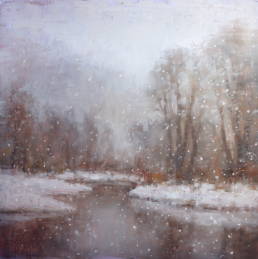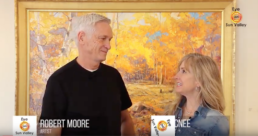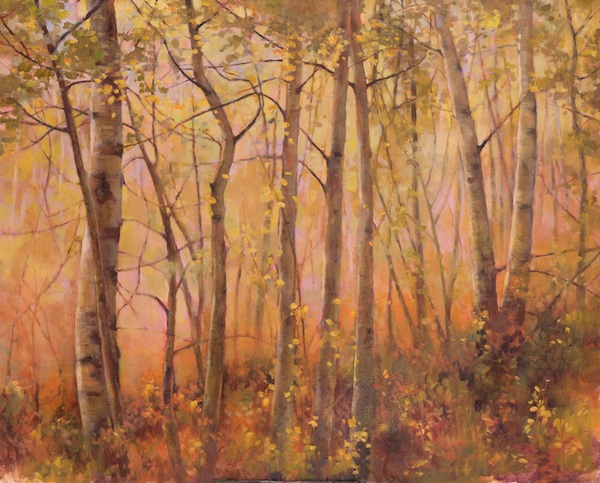Kneeland Gallery Exhibition and Artists' Reception in Sun Valley, Idaho
MARK GIBSON, LORI MCNEE, CALEB MEYER
Exhibition: December 14th – January 27th
Artists' Reception: Friday December 30th, 5-7.30pm
Come meet the artists on Friday. December 30th, 5-7:30pm at Kneeland Gallery during the world famous Sun Valley Gallery Walk! 'Tis the most festive time of year in magical Sun Valley.
Hope to see you there! ~Lori

From Farm Boy to Painter My Interview with Artist Robert Moore
One of the greatest joys of my 'job' is working with wonderful artists from all over the world. Recently, I interviewed my longtime artist friend, Robert Moore on my new show, "Art Beat with Lori McNee." (produced by Eye on Sun Valley.)
We met at Kneeland Gallery to view Robert's newest oil painting exhibition in Sun Valley, Idaho. During this inspiring interview, Robert explained how he went from being an Idaho farm boy to a renowned landscape painter.
Robert is a talented, yet humble man. With the support of his wife, Robert has built a successful art career, reared 6 amazing children, and apprenticed many successful artists along the way. Through adversity, including being colorblind, Robert has created a distinctive painting style of his own. His paintings are in top art galleries and important art collections around the world. Robert is also a popular workshop instructor. In fact, I painted my very first still life painting when I attended a Robert Moore workshop over 20 years ago!
I hope you enjoy learning a bit more about the man behind the bold, beautiful aspen paintings for which he is known.
A Sneak Peek - Lori's Latest Oil Paintings
Here's a sneak peek at my latest oil paintings which are on exhibit at Kneeland Gallery in Sun Valley, Idaho.
All in all, I painted 20 new oil paintings ranging from 48 x 24 inches down to 8 x 8 inches with a variety of subject matter. You will find magical and unique still life paintings with beautiful birds, as well as luminous studio landscapes, some with wildlife, and a few plein air paintings.
I hope you enjoy viewing my paintings via the Instagram post below. My work looks extra special when displayed on the walls of elegant Kneeland Gallery.
Perceptions of Nature - My New Encaustic Paintings

This winter I have been working really hard at a new series of artwork - encaustic wax paintings.
Working with encaustic wax is a tactile, poetic, emotional experience. I am seduced by the alluring, organic translucencies of the encaustic medium. Labor intensive and difficult to master, the wax has a mind of its own, but this makes the medium even more exciting.
When painting with encaustic, I am embracing the ‘unknown’ and enjoy the experience of being out of control.
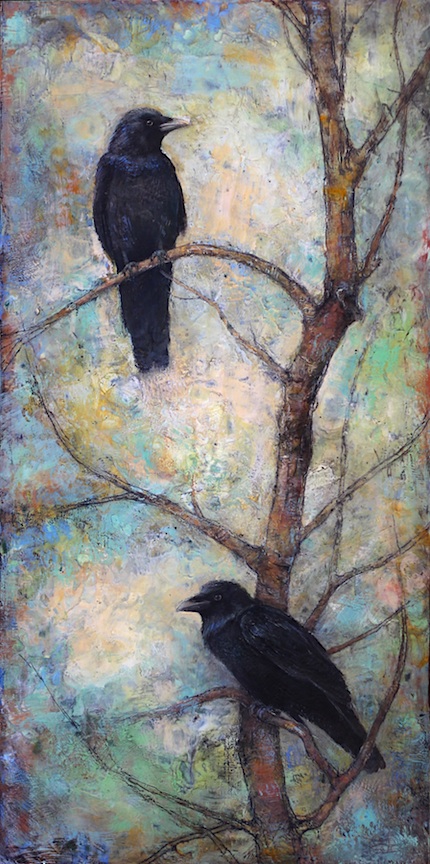
Night Watch - Ravens
48 x 24
encaustic
Through countless hours of experimentation I have developed my unique encaustic painting technique, which conveys the ethereal, atmospheric qualities of the wax and the subject - in this series, the birds. I am proud to display my new works alongside the amazing bird sculptures of Greg Woodard. Our work really compliments each other!
I hope to meet some of you in Sun Valley, Idaho at our Kneeland Gallery artists' reception Februray 14, from 5-8. The show will be hanging until until March 3, 2014. Also showing will be talented painters, Shanna Kunz and Steven Lee Adams. Come say hello!
*Let’s also meet on Twitter, and on Google Plus, Pinterest, and join in the fun at Fine Art Tips Facebook Fan Page! Please checkout my art too LoriMcNee.com, or find me on Instagram lorimcneeartist.
20th Anniversary of Plein Air Painting in Sun Valley, Idaho
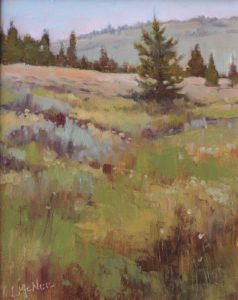 Each year, I have the wonderful opportunity to plein air paint with a talented group of artists as well all congregate in the beautiful mountains of Sun Valley, Idaho for Kneeland Gallery's annual paint out.
Each year, I have the wonderful opportunity to plein air paint with a talented group of artists as well all congregate in the beautiful mountains of Sun Valley, Idaho for Kneeland Gallery's annual paint out.
This week we have been painting out in the mountains and celebrating the art gallery's 20th anniversary. Art spectators have been watching up create paintings in the field which culminates with the artists' reception tonight.
If any of you happen to be in the Sun Valley area, I hope you will stop by and meet the artists and see our latest paintings!
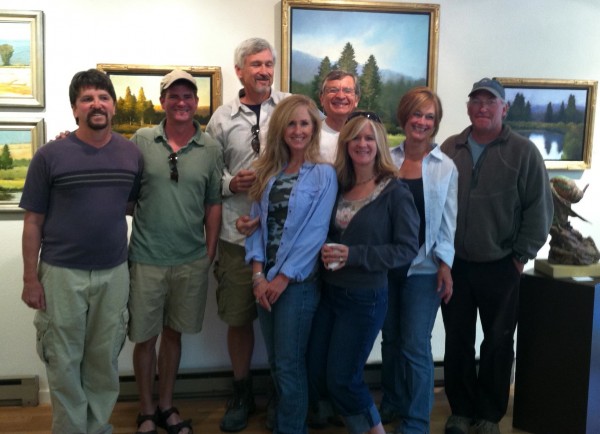
Pictured above: Jack Brahman, Steven Lee Adams, Robert Morre, Lori McNee (me), John Horjes, Shanna Kunz, Linda Tippets, Bart Walker.
July 29th-August 29th
Kneeland Gallery 20th Annual Plein Air Exhibition
Painting Dates: August 3rd, 4th and 5th
Reception: Friday August 5th, 5-8pm
(For more information about the event or my paintings, please call Kneeland Gallery (208) 726-5512
You might enjoy reading the following articles:
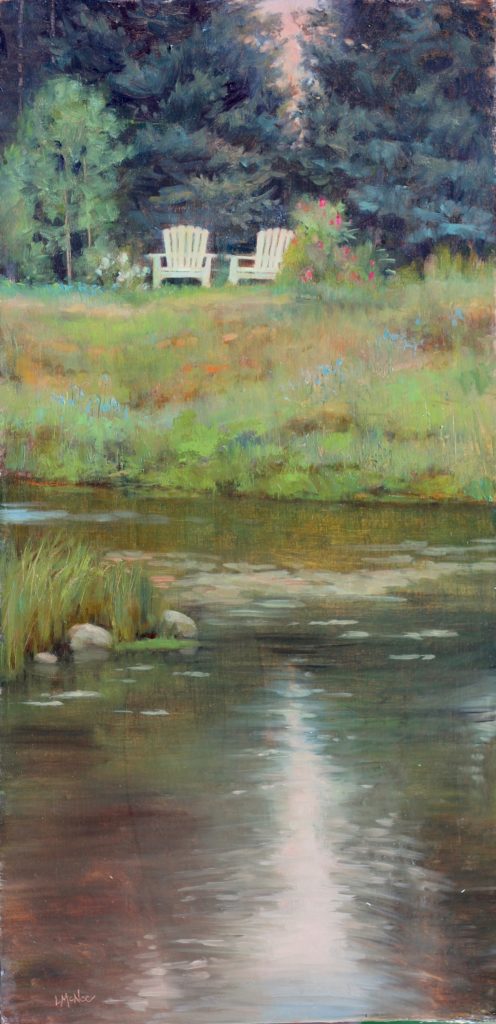
The Right Gallery - How to Find One
Plein Air Painting with Nationally Known Artists
How to Stage Your First Art Exhibition
10 Tips to Bring Visitors to Your Art Fair Booth or Open Studio
How to Make Your Art Portfolio Current & Competitive
10 Motivating Tips for the Plein Air Painter
Although some of my readers are from around the world and warmer places, many of us have endured an extra long, cold and grey winter. In fact, there is still about 3 feet of snow in my yard! But, the hint of spring is finally in the air here in Idaho, and I can't wait to get out my plein air pochade 'toy' box!
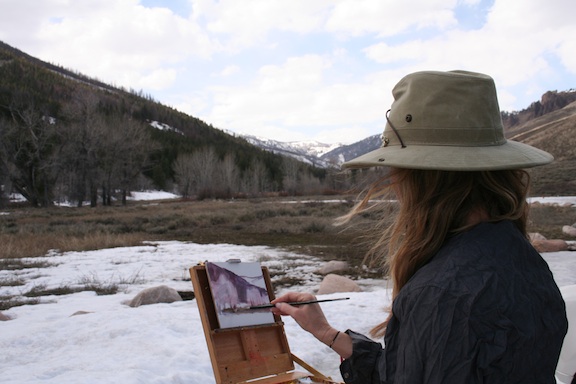
I am willing to bet, many of you plein air painters are feeling the same way. Nevertheless, some artists might feel blocked or intimidated when making the transition from the comforts of their studios and out into Mother Nature's studio - whether in the city or the country. Below are 10 tips written by my friends at ArtBistro to help get us all get motivated and ready for some outdoor, en plein air painting.
Guest author: ArtBistro. The following article was originally posted on ArtBistro.Monster.com
1. You will have to do deal with your natural self-consciousness.
Most people don’t enjoy looking and feeling conspicuous. Even exhibitionists prefer blending in most of the time! So you need to talk yourself into a willingness to be seen, watched, pointed at, gawked at, criticized, and all the rest. You may turn out to be much more invisible than you fear—but if you aren’t, so be it!
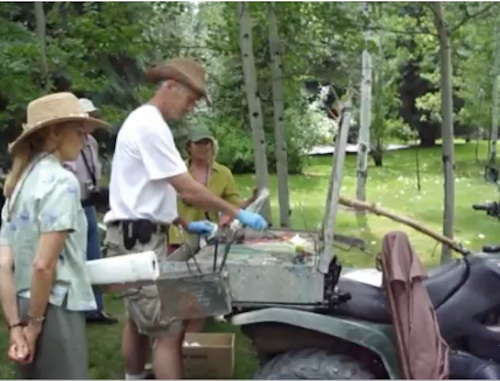
2. You will have to deal with a vast amount of visual data.
When you’re in front of your canvas while plein air painting, you have only whiteness to look at, which can be its own problem. But that’s a very different problem from the staggering amount of visual material available to you as you wander in the world. Wherever you turn your head, there is more to see! Accept this reality and talk yourself into the belief that all this visual data is a special kind of abundance, not some sort of problem.
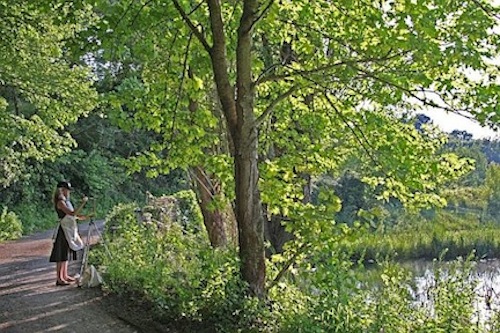
3. You will be obliged to make choices.
You can’t paint everything you see! Even if that were possible, what would be the point? Isn’t the artistry in the choosing? Choosing provokes anxiety and having to make strong, clear choices about what to paint may well raise your anxiety level. Be prepared for this anxiety, know what you’re going to do to combat it, and accept that you have no choice as an artist but to choose.
4. You need to bring a painting set-up that works for you.
This may take repeated tries, as the first set-up may be too cumbersome, the second set-up too meager, and so on. Learning how to feel comfortable en plein air is a process and there is no reason why you should nail your set-up the very first time. Consider your first tries experiments and learn from them.
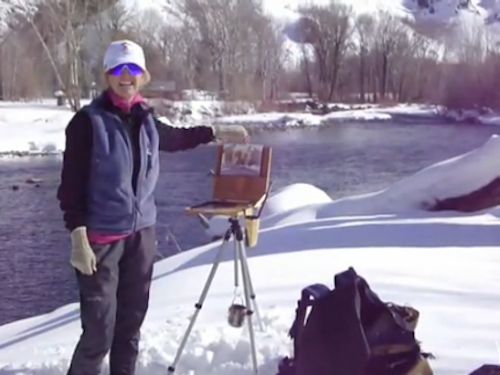
5. You will need to be clear about your intentions.
Are you planning to make finished paintings while you’re out? Or loose sketches? Or something in between, something that’s more than a sketch but that still requires work back at the studio? Maybe you actually don’t know your intentions—in which case, try to learn them as you go. Maybe you’ll discover that you can complete things on the spot and maybe you’ll learn that your real goal is to capture a sense of place and finish up at the studio. Learn as you go.
6. You will need to think about partners and buddies.
Would you enjoy going out with a friend? Maybe several of you might travel together? You don’t have to confine yourself to one way or the other—usually Van Gogh went out alone but sometimes he went out with Gauguin. Think through the pros and cons of painting en plein air with a buddy and if the pros tip the scale in their favor, find a painting partner.

7. You will need to schedule real time for the experience.
Most people are so busy nowadays that they can’t find three or four hours “out of nowhere” unless they consciously pencil those hours into their schedule. Look at your schedule and make some decisions about where you might find your en plein air time. If you can’t find the time, that means that in order to get en plein air painting onto your schedule you will need to rethink how you spend your time.
8. You will need to remind yourself of the joys of en plein air painting.
You may be focusing in your mind on the difficulties associated with it and by focusing on them have forgotten how joyful it can be to be out in the world looking, seeing, and creating. Think back to how much you’ve enjoyed sketching in parks and cafés. The studio is great—but so is the world. Remind yourself of its greatness!
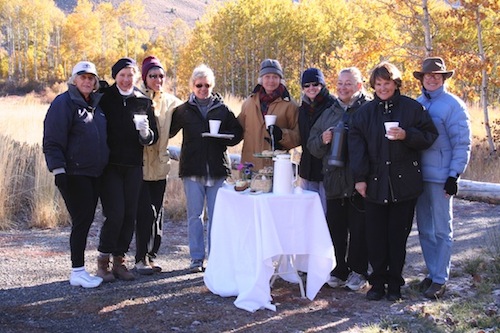
9. You will need to keep the process simple and not over-dramatize it.
It isn’t as if you’re going to the ends of the earth! We can easily talk ourselves into the belief that something is far more difficult than it really is. Have a quiet conversation with yourself, gather up a few things, go out, and find some fascinating vistas to paint. Don’t over-dramatize the difficulties!
10. You will need to have a conversation with yourself about the importance of en plein air painting to your creative life.
If in the course of that conversation you decide that it is more a romantic fancy or a “should,” let it go. But if you decide that it is central to your growth and something that matters to you a lot, honor your understanding of its importance and make sure that you get some en plein air painting on your schedule—and soon!
*****
Plein air painting is a wonderful pastime. I encourage you to get out there and try it! This discipline will improve your studio art dramatically. Please share your plein air tips with us in the comment section. We all learn from one anther! ~Lori
PS. Please, let's meet on Twitter and my FineArtTips Fan Page.
You might enjoy some of these other articles:
How to Use Good Reference Photos for Landscape Painting
How to Build a Pochade Box from a Cigar Box
How to Interpret the Landscape in Paint
Plum TV Presents, “A Day in the Life of Artist Lori McNee”
Save Studio Space! How to Make Your Own Painting Racks
How to Pack For Painting – Tips for the Painter Traveling by Airplane or Car
7 Ways to Get Motivated in the Studio to Sell More Art
New Still Life Paintings by Lori McNee: "Illusionary Realism" at Kneeland Gallery
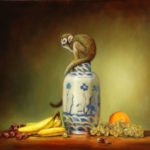
Each winter I am honored with the opportunity to showcase my newest works with an emphasis on still life painting at Kneeland Gallery in Sun Valley, Idaho.
I have been working all winter preparing for the gallery reception and exhibition which starts this Friday night, March 5th and runs through April 15th, 2010.
I thought my readers might enjoy seeing what I do when I am not blogging or 'twittering'...and yes, I really do paint and do my best to practice what I preach! It is a challenge to juggle it all, especially when you throw in a few kids, dogs and a cat into the mix but, the rewards make it all worth the effort.
I like this quote I found the other day: "If you are irritated by every rub, how will you be polished?" ~Rumi
We all feel the 'rub' especially when we feel the pressure to paint a great show. I hope all that 'rubbing' has polished my artistic skills.
Below is a sampling of my newest still life paintings. Oh, and if you are in the area please stop by and say hi!


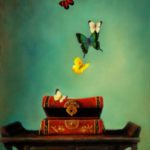

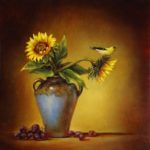
(above paintings are all original oils by Lori McNee, copyright 2010 - for more information contact Kneeland Gallery or visit my website www.lorimcnee.com)
Plein Air Painting in Idaho with Nationally known Artists
Each summer I have the priveledge of plein air painting alongside a talented group of Nationally recognized artists during a week long event hosted by Kneeland Gallery of Sun Valley, Idaho. Being an artist consists of many isolated hours alone in our studios or painting out in the field, so this is a special time for us all.Read more
The Right Art Gallery – How I Found Mine
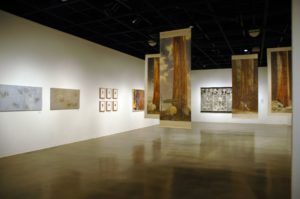 You now you have a better idea of how to find the right gallery. So, I thought you might be interesting in my personal 'gallery shopping' story.
You now you have a better idea of how to find the right gallery. So, I thought you might be interesting in my personal 'gallery shopping' story.
But first, a few relevant thoughts:
Whether you want to admit it or not, being an artist is kind of like being in show business. We are in fact – entertainers or even celebrities of sorts. You will find this to be true anytime you put yourself out there in the public eye: i.e. gallery exhibitions, museum exhibitions, lectures, publications, etc.
Do you ever watch American Idol? On that popular television show, thousands of talented and not-so-talented young people put themselves through public scrutiny and humiliation while trying to reach for fame and fortune. It is very entertaining to watch the good-the bad-and-the ugly perform and then judged. Just in case you are not familiar with American Idol…a panel of 4 judges comment after each singing performance. Their personalities range from "Simon," with his harsh realistic opinions that slash to the core, to flowery "Paula," (now sense retired) who tends to ‘sugar-coat’ her comments with positive reinforcement.
Not to discourage you but, this is an analogy for what the gallery world can feel like. That is why I made the many suggestions in the article, The Right Gallery - How to Find One. Gallery directors and owners come in all shapes, sizes and personalities. I am trying to help you minimize the discomfort and artistic temperament that most artists feel in case you come upon a “Simon” while gallery shopping...
Back to my story:
I won’t bore you with my whole life story, but in short - I was born with a pencil in my hand and for as long as I can remember, I have always drawn. However, I didn’t start painting until the late 1980’s when my kids were babies. In between loads of laundry and nap-time I would paint. To motivate myself, I took painting workshops and illustrated (often for free) for the Nature Conservancy, Ducks Unlimited, and the Wolf Education Research Center. I also entered many art competitions including duck and trout stamps. This kept me painting, creating, and improving my craft.
Things started to happen:
- My drawings & paintings were being published and my local newspaper and Sun Valley Magazine did articles about my art.
- This got the attention of the art community.
- From there, I had an introduction to Zantman Gallery in Carmel, California.
- A mutual friend introduced my work to the director and the gallery started to represent me.
- Also at that time, Kneeland Gallery offered to show my work too.
- Before I knew it, I was in two galleries (each with 2 locations).
- Great - right? Wrong. The problem was this…I WAS NOT READY FOR A GALLERY!
- Why? I was such a busy full time mom; I could not physically produce enough fresh work to keep the galleries happy.
- So, I pulled my work out of the gallery world for another 12 years. Even though my artwork was technically good enough to be in a gallery – I was not ready.
But, during that 12 year gallery break, I continued to work on developing my skill and own personal style. The quality of my paintings grew a lot as I studied with many world renowned artists, read great art books and watched inspiring videos.
Fast forward 12 years….here’s what happened!
- After I read Kevin McPherson's instructional book, “Fill Your Painting with Light & Color,” I was inspired to paint one small field painting every day.
- As an exercise I did this, and by the end of summer I had close to 100 ‘little gem’ paintings!
- Soon after, a girlfriend offered to show these little works in her interior decorating store –it was in a perfect location down ‘gallery row’.
- I had a sellout show!
- This caught the attention of two nationally recognized galleries in my hometown, Kneeland Gallery and Gail Severn Gallery.
- Both galleries offered to represent me.
- I chose Kneeland because I felt my work was more compatible with their current theme.
- Before I knew it, I was having successful shows and advertising in major magazines.
- An ad in Southwest Art Magazine caught the attention of Gardner Colby Gallery in Naples, Florida and soon I was represented on the east coast too!
Now I felt ready to branch out a little further…a fellow artist referred me to a gallery in Jackson Hole, Wyoming – they took a chance on me and presto, another gallery! Then came Scottsdale and New York….but, my overachieving caught up with me and I had to drop them and went back to the basics.
I have learned a lot along the way and hope my story can help you. Most importantly, any successful relationship takes work and nurturing. I have great rapport with all my galleries and communicate with them frequently. I let them know I appreciate all they are doing for me.
A few personal tips:
- I SELL MYSELF FIRST! I smile, I am friendly, and show my personality.
- I am prepared and informed
- I am professional
- I look my best (but not overdone!)
- I dress according to the demographics - if the gallery is in the city, I dress up a bit (basic black is always safe). In Jackson or Sun Valley I wear a nice pair of jeans and a blouse or sweater.
- MAKE SURE YOU ARE READY FOR A GALLERY. (This means you have the time to devote to your art – learn from my mistake.)
- REALIZE THAT GOOD GALLERIES NEED GOOD ARTISTS
- Interview the gallery
- Maybe you’d rather work with a Paula instead of a Simon
- If you’re not ready but want to get your feet wet, you can set up occasional shows by approaching a restaurant, interior design firm, real estate office, bank or coffee house. Treat them as though you would a gallery.
- Believe in yourself and remember it's your choice.
- And lastly…In the wise words of the strange but talented pop star, Lady Gaga (she was a struggling artist for years) – “Do what you love and the Universe will support you!”
Lori :)
The Right Art Gallery - How to Find One
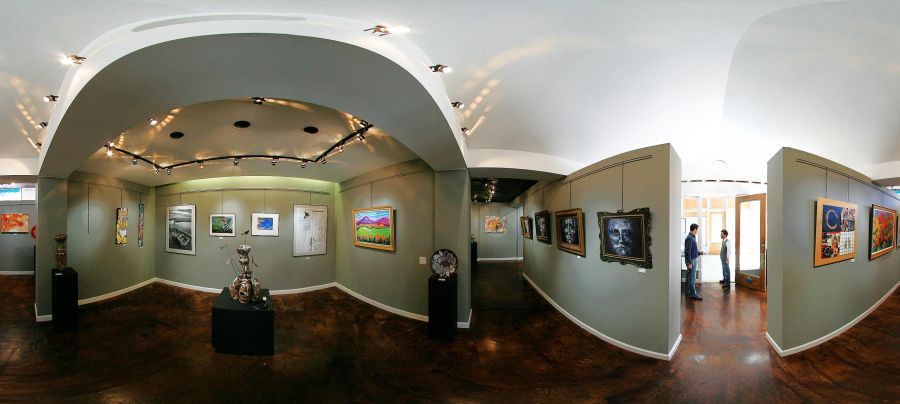
Finding a new gallery for your art can be a daunting task for many artists and not all artists have that natural-sales-ability.
But, the number one Cardinal Rule for any type of sales is to sell yourself! So how does one do that?
First of all, honestly ask yourself a few important questions:
- Am I ready for a gallery?
- Is my art saleable?
- Is my art technically good?
- Have I developed a recognizable style?
- Do I have a cohesive body of work ready to display?
- Have I had success selling my work in art/craft shows, out of your studio and other non-gallery venues?
- Do I have the time to fulfill the supply & demand of a gallery?
- Do I have a website that showcases my art and information? (This is not a must, but highly suggested)
- Do I have a portfolio, bio, resume & artist statement?
If the answers are yes, great – you might be ready to take the next step toward finding the right gallery. If the answer is no, then don’t put yourself in a vulnerable position.
Approaching a gallery before you are ready is kind of like putting a gangly teenager in modeling school. It won’t help your self-esteem and it most likely will bruise your ego. Be patient and hone your craft until the ugly duckling turns into a swan.
Okay. So you are ready for a gallery. Now it is important to do-your-homework and think about where your artwork belongs in the art market. This is easy to do and you can start from home:
- Flip through art magazines and look at gallery ads and the artists they represent.
- Checkout gallery websites and see if your work would be a good fit for them.
- Talk to fellow artists and have them suggest galleries to you.
- If you paint traditional floral still life paintings don’t bother approaching a gallery that specializes in contemporary abstract art.
- On the other hand, all galleries are looking for that fresh artist to add to their “artists’ stable” but - within its own genre.
- The next step is to venture out and visit some local galleries in your area or take a road trip to some galleries of your targeted art market.
- But, observe the gallery through the eyes of a collector, not as an artist.
- Watch and see how the staff greats and treats you. Are they courteous and professional?
- Walk through the gallery and scan the art, look how it is hung and check the lighting.
- Ask for a price sheet if available. Be sure and get references on the gallery from other artists.
- Try and visualize your art hanging in the gallery and see how it compares in quality to their other artists.
- Searching for the right gallery is a process of elimination.
- The more galleries you visit and research, the more informed you will be about making the right choice.
- Now you have a short list of galleries that are a good match and you are ready to approach a gallery.
- But, remember that a successful gallery with a good reputation gets inundated with dozens of artists’ submissions each week.
I work closely with Kneeland Gallery who represents me. They all have stellar reputations and therefore they are flooded with artists’ inquiries each week. So how do you make yourself stand out from the crowd?
Check your target gallery website and see if they do or don’t have specific protocol for artists’ submissions. If they do have guidelines, follow them (or be a rebel and do it your own way, but you might get shut down). If there are no guidelines then you can try some of the suggestions below:
But, first a bit more about Specific Gallery Requirements:
Some galleries, especially within the high end fine art market have specific submission requirements and policies. Usually artists must submit work for review. This generally means a professional portfolio of at least 10 slides, photos or transparencies or a CD depicting recent works. Please read how to Create a Powerful Portfolio for up to date advice from a gallery owner. Always send a self-addressed, stamped envelope or risk never seeing your material again.
The Portfolio Submission:
If you chose to send a portfolio directly to your chosen gallery, be sure and follow the guidelines mentioned above. Most artists today still simply send in a marketing package that includes a professional portfolio which often times get stacked up in a pile and overlooked. Don’t try and get too cleaver with the presentation. Keep your portfolio tailored, professional and filled with your best work. It is a good idea to follow up two weeks later with a phone call.
The Cold Call:
This is where you pick up the phone and call the chosen gallery and pitch yourself. Practice and have a notepad with your thoughts outlined so you don’t ramble. At this point, be ready to sell yourself because there is no artwork to hide behind over the telephone. Here are a few hints to help you make that call…
- Check the gallery hours and exhibition schedule. If there is an event scheduled, make your call at least a week before or a week after the after the event.
- You minimize the risk of interrupting a busy and stressed out director.
- It is best to make phone calls either in the morning or at the end of the day. This is when busy directors most generally are at their desks.
- And…make calls during the middle of week.
- Ask to speak with the Director. If he/she is not available ask when he/she will be available and do not leave a message. (You might not get a return call) So, you call back later.
- Keep the conversation short, friendly and to the point.
- Introduce yourself, explain that you are interested in their gallery, and briefly tell them a little bit about you and your art and why you are a match for them.
- Follow up the conversation with an email linking to your website or attach a few jpeg images of your work – do this within a day so they don’t forget you.
- Mention in your email that if you don’t hear back from them, you will check back – give them one to two weeks.
- Or ask the gallery if they would prefer a portfolio, slides or a website to review
The Walk In:
Get ready to sell yourself. This is a more aggressive approach that can or can’t work – it all depends on how attuned you feel with the director or owner. There are no set rules so be ready to go-with-the-flow. Here are some ideas to help you take that step in the door:
- Just like the ‘cold call’ check the gallery schedule and make sure you are not interrupting a major event or busy time.
- Hopefully you have done your homework and familiarized yourself with the gallery.
- Look your best.
- Ask to speak with the owner or director
- Be informed and demonstrate that you understand the gallery program.
- Let them know why your work is a good match.
- Do not walk in with paintings tucked under your arm – this looks desperate.
- Leave a business card with your website information or a portfolio for their review.
- Don’t overwhelm them with too much information, leave them wanting more.
- Walk in with a good attitude. Be courteous.
Now let’s say they really like you and things have gone well…they might ask to have you send them a few paintings for their approval – or they might ask to see some work in person. At this point (this has worked for many of my artist friends, especially when they are on a road trip) have few small framed samples of your best work out in the car.
The Look-see:
Invite your targeted gallery to visit a current showing of your work. Many artists show their art is art/craft shows, restaurants, banks, interior design firms, frames shops and their own studios. If you are lucky enough to live in a community that has a possible gallery for you this approach might work. I suggest you send a printed invitation with an image of your art to the director followed up with a phone call.
The Referral:
This is the best way of approaching a gallery. It has worked wonders for me in the past. If you network with other artists, you most likely have friends with good connections. And yes, just like in Hollywood – it’s who you know. Ask your artist friend to recommend you to their gallery. Make sure to have your friend send them to your website or give them a portfolio of your art. This will peak the gallery’s interest in you. Within a week it is up to you to follow through. Give them a call and remind the gallery that they were recommended to you by your mutual artist friend. From there, hopefully you can build a working relationship.
The Gallery Request:
“If the mountain can’t go to Mohammad, let the mountain come to Mohammad.” What do I mean by that familiar, old statement? This is when the gallery approaches you! Yes, this does happen and has for me many times. But before you say, ‘yes,’ make sure to check the gallery’s references and business record. If they measure up and look like a good fit, this can be the best of all worlds. The gallery picked you. That means they are excited to show your work in their gallery – and this can mean more sales.
The above suggestions are advice that I have compiled from my years as an artist and talking with galleries and fellow artists. We all have battle scars and war stories to tell, but I hope these ideas help keep your pain to a minimum.
But, remember – “If at first you don’t succeed, try, try again." and "Don't be discouraged. It's often the last key in the bunch that opens the lock."
You might enjoy these posts:
The Right Gallery - How I Found Mine.
5 Reasons Why Artists Need Social Media & Eye Opening Stats to Back it Up!
Newsletter Art Marketing Tips that Work!
5 Common Traits of Successful Artists
One Simple and Effective Way to Show the World You're a Pro
Create a Powerful Portfolio
How I Landed Two Galleries in One Weekend


